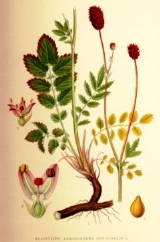
Sanguisorba officinalis
Encyclopedia
Sanguisorba officinalis (Great Burnet) is a plant in the family Rosaceae
, subfamily Rosoideae
. It is native throughout the cooler regions of the Northern Hemisphere
in Europe
, northern Asia
, and northern North America
.
It is a herbaceous
perennial plant
growing to 1 m tall, which occurs in grasslands, growing well on grassy banks. It flowers June/July.
Sanguisorba officinalis is an important food plant for the European Large Blue butterflies Maculinea nausithous and M. teleius.
 Use is made of its extensive root system for erosion
Use is made of its extensive root system for erosion
control, as well as a bioremediator, used to reclaim derelict sites such as landfills.
The leaves are used in salads because they are mildly reminiscent of cucumber. Selective pruning of apical meristems, such as at flower heads, is used to encourage an increase in leaf production.
(TCM) for thousands of years, probably through the employment of the doctrine of signatures
as a treatment for bleeding.
Specifically, the root is used to stop blood
y dysentery
, nosebleeds, and is applied topical
ly to treat burns and insect bites.
Rosaceae
Rosaceae are a medium-sized family of flowering plants, including about 2830 species in 95 genera. The name is derived from the type genus Rosa. Among the largest genera are Alchemilla , Sorbus , Crataegus , Cotoneaster , and Rubus...
, subfamily Rosoideae
Rosoideae
The rose subfamily Rosoideae consists of more than 850 species, including many shrubs, perennial herbs, and fruit plants such as strawberries and brambles...
. It is native throughout the cooler regions of the Northern Hemisphere
Northern Hemisphere
The Northern Hemisphere is the half of a planet that is north of its equator—the word hemisphere literally means “half sphere”. It is also that half of the celestial sphere north of the celestial equator...
in Europe
Europe
Europe is, by convention, one of the world's seven continents. Comprising the westernmost peninsula of Eurasia, Europe is generally 'divided' from Asia to its east by the watershed divides of the Ural and Caucasus Mountains, the Ural River, the Caspian and Black Seas, and the waterways connecting...
, northern Asia
Asia
Asia is the world's largest and most populous continent, located primarily in the eastern and northern hemispheres. It covers 8.7% of the Earth's total surface area and with approximately 3.879 billion people, it hosts 60% of the world's current human population...
, and northern North America
North America
North America is a continent wholly within the Northern Hemisphere and almost wholly within the Western Hemisphere. It is also considered a northern subcontinent of the Americas...
.
It is a herbaceous
Herbaceous
A herbaceous plant is a plant that has leaves and stems that die down at the end of the growing season to the soil level. They have no persistent woody stem above ground...
perennial plant
Perennial plant
A perennial plant or simply perennial is a plant that lives for more than two years. The term is often used to differentiate a plant from shorter lived annuals and biennials. The term is sometimes misused by commercial gardeners or horticulturalists to describe only herbaceous perennials...
growing to 1 m tall, which occurs in grasslands, growing well on grassy banks. It flowers June/July.
Sanguisorba officinalis is an important food plant for the European Large Blue butterflies Maculinea nausithous and M. teleius.
Commercial Uses

Erosion
Erosion is when materials are removed from the surface and changed into something else. It only works by hydraulic actions and transport of solids in the natural environment, and leads to the deposition of these materials elsewhere...
control, as well as a bioremediator, used to reclaim derelict sites such as landfills.
The leaves are used in salads because they are mildly reminiscent of cucumber. Selective pruning of apical meristems, such as at flower heads, is used to encourage an increase in leaf production.
Ethnomedical Uses
It has been in use by Traditional Chinese MedicineTraditional Chinese medicine
Traditional Chinese Medicine refers to a broad range of medicine practices sharing common theoretical concepts which have been developed in China and are based on a tradition of more than 2,000 years, including various forms of herbal medicine, acupuncture, massage , exercise , and dietary therapy...
(TCM) for thousands of years, probably through the employment of the doctrine of signatures
Doctrine of signatures
The doctrine of signatures is a philosophy shared by herbalists from the time of Dioscurides and Galen. This doctrine states that herbs that resemble various parts of the body can be used to treat ailments of that part of the body. Examples include the plants liverwort; snakeroot, an antidote for...
as a treatment for bleeding.
Specifically, the root is used to stop blood
Blood
Blood is a specialized bodily fluid in animals that delivers necessary substances such as nutrients and oxygen to the cells and transports metabolic waste products away from those same cells....
y dysentery
Dysentery
Dysentery is an inflammatory disorder of the intestine, especially of the colon, that results in severe diarrhea containing mucus and/or blood in the faeces with fever and abdominal pain. If left untreated, dysentery can be fatal.There are differences between dysentery and normal bloody diarrhoea...
, nosebleeds, and is applied topical
Topical
In medicine, a topical medication is applied to body surfaces such as the skin or mucous membranes such as the vagina, anus, throat, eyes and ears.Many topical medications are epicutaneous, meaning that they are applied directly to the skin...
ly to treat burns and insect bites.

